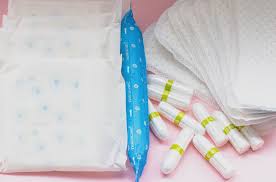
Inside your period products : what you (really) need to know
Have you ever wondered what’s actually in your tampons or sanitary pads? Unlike most personal care products, the packaging of menstrual products often doesn’t list their ingredients. This lack of transparency can be concerning, especially given the lack of regulation requiring brands to disclose the full composition of these products unless they contain one of 26 known allergens.
We think it is important to raise awareness about it, both for our our health and the environment. Traditional menstrual products are potentially harmful to women health, and they are also disposable, which contributes significantly to global waste. On average, a person will use approximately 250 menstrual products a year for over 35 years, and it will take up to 500 years for each pad to decompose (as long as a plastic bottle) — the numbers quickly add up!
So, what’s really inside your pads and tampons? Let’s discuss the ingredients and explore healthier alternatives that are kinder to both your body and the planet.
What are menstrual products made of ?
When examining a package of sanitary pads or tampons, you might notice something missing: the list of ingredients! This is because manufacturers aren’t obligated to disclose the materials used unless they include certain allergens. Based on research and information from official websites of brands or consumer associations, here’s what’s typically inside traditional non-organic menstrual products :
Sanitary Pads and Panty Liners :
- Top Layer: Usually made of synthetic fibers (non-woven polypropylene), derived from plastic.
- Secondary Layer: Often made of plastic derivatives to direct menstrual flow.
- Absorbent Core: Typically made from cellulose fibers (wood or other organic materials) and may contain absorbent microbeads or fragrances.
- Waterproof Outer Layer: Designed to prevent leaks, usually made from synthetic fibers like polyethylene or polypropylene.
- Adhesive Layer: Adhesive strips help the pad stay in place and often contain plastic derivatives or compostable cellulose film.
Other common ingredients include cotton, synthetic super-absorbent polymers (SAP), chlorine, viscose, dyes, phthalates, aluminum, alcohol, and even pesticides like glyphosate. Many of these components are petroleum-based and some are classified as endocrine disruptors.
Tampons :
- Absorbent Layer: Typically made from cellulose fibers (cotton or viscose) or synthetic fibers.
- Core: Usually made of cotton or viscose.
- String: Can be made from cotton, polyester, or polypropylene.
- Outer Wrapping: Plastic for hygiene purposes, and if an applicator is used, it’s often made of plastic as well.
Tampons may also contain fragrances, chlorine, and other synthetic materials. Additionally, they can contain dioxins, pollutants released during the bleaching process.
Health risks of menstrual products :
While small quantities of these ingredients may be present, limited research exists on their long-term effects. Prolonged exposure to certain chemicals can lead to allergic reactions, skin irritations, or infections. The use of endocrine disruptors in menstrual products raises concerns about their potential link to health issues like fertility problems and increased cancer risk.
External menstrual products
While no significant health risks have been directly linked to external menstrual products, their contact with the sensitive vaginal area can lead to issues like allergies, itching, or infections. They can also disrupt the natural pH balance of the vagina, weakening the body’s defense against harmful bacteria. If you notice unusual symptoms after your period, consult a healthcare provider.
Internal menstrual products
Tampons carry similar risks, including irritation, itching, and allergic reactions. The presence of endocrine disruptors can also potentially affect reproductive health over time.
Toxic shock syndrome (TSS)
TSS is a rare but serious condition often associated with tampon use. Although it can occur in anyone, tampon users are at higher risk because the prolonged use of internal menstrual products (such as tampons or cups) can introduce harmful bacteria into the body. To reduce the risk :
- Wash your hands before inserting or removing tampons, menstrual cups, or other internal products.
- Use tampons appropriate for your flow.
- Change tampons every 4 to 6 hours.
- Sterilize menstrual cups between cycles.
- Avoid using internal products overnight.
Healthier alternatives :
There are healthier, more eco-friendly alternatives available. Organic menstrual products (like organic cotton pads and tampons) are made from materials that avoid the use of pesticides and synthetic chemicals. These products typically contain 100% natural fibers, making them hypoallergenic and much gentler on the skin.
For those looking for more sustainable options, reusable products like period underwear (have you heard about Bonnie locally made period panties? 🙂), cups and washable pads are great choices. Not only are these options better for vaginal health, but they’re also better for the environment.
While traditional menstrual products may seem convenient, their hidden ingredients and potential risks should encourage us to reconsider what we’re putting on and in our bodies. Fortunately, healthier, more transparent alternatives exist, such as Bonnie period panties (visit our e-shop!). By choosing organic or reusable options, we can prioritize our health and reduce our environmental impact.
